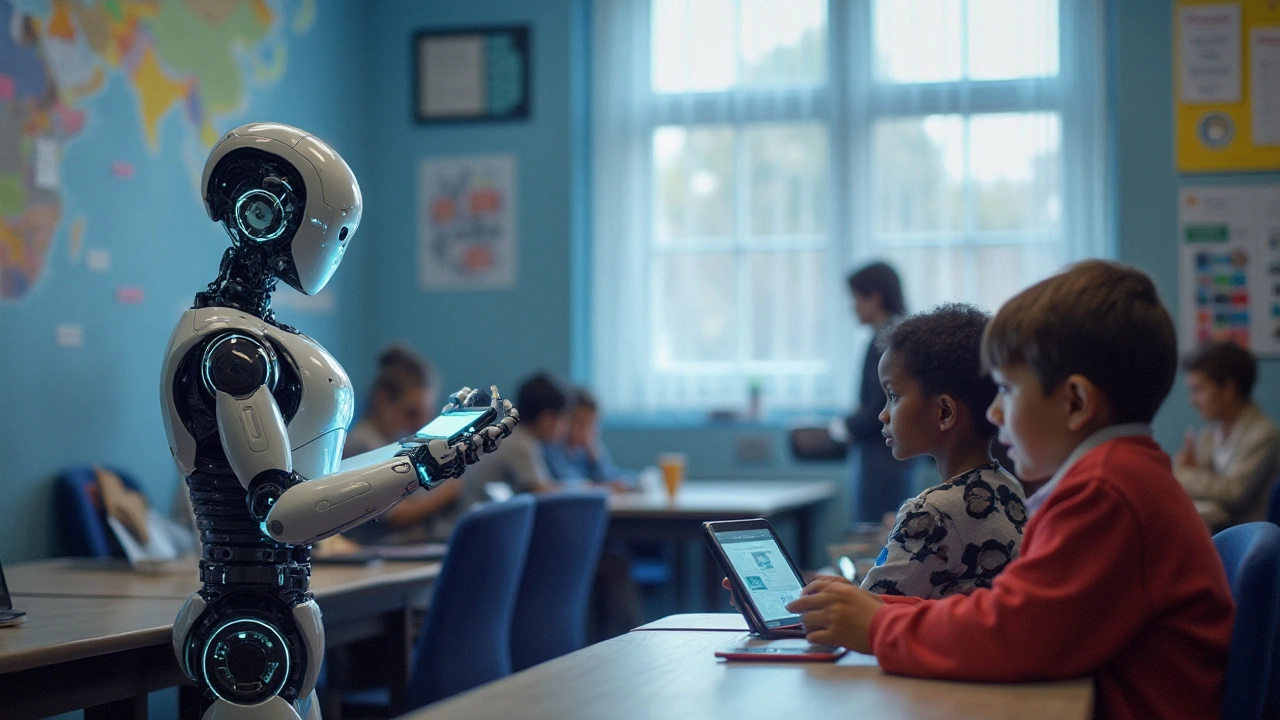Artificial Intelligence, often shrouded in mystique and cinematic exaggeration, is radically shaping the world as we know it in 2024. Its magic isn't conjured from sorcery but from data, algorithms, and relentless innovation. For many, the realm of AI feels distant, a universe that only techno-gurus can inhabit. Yet, the reality is that AI is for everyone willing to take a curious stride into this exciting domain.
Diving into AI doesn't mean you need to have a PhD in computer science. With our ever-connected world, the power to learn is at your fingertips. This guide is here to break down barriers, explaining AI from its humble beginnings to its futuristic ambitions. Whether it's your first foray into AI or you're brushing up on the latest trends, this guide aims to enlighten and inspire. AI isn't just a tool for the tech-savvy—it's a toolkit for anyone ready to understand the building blocks of the future.
- Understanding Basic AI Concepts
- The History and Evolution of AI
- Practical Applications of AI Today
- Getting Started with AI Tools
- Future Prospects and Ethical Considerations in AI
Understanding Basic AI Concepts
Artificial Intelligence, or AI, has become a buzzword swirling around discussions about technology's future. But what exactly is AI, and why is it so significant? At its core, AI is the science of making machines think and learn like humans. It's about creating algorithms that enable computers to solve problems and make decisions with human-like intelligence. Imagine teaching a computer to recognize faces in a crowd, predict your next favorite song, or drive a car. These capabilities are among an expanding array of AI applications.
The roots of AI trace back to mid-20th-century visions of intelligent machines. In those days, AI research focused on teaching computers to accomplish tasks that required human intelligence, like playing chess. One significant milestone was IBM's Deep Blue defeating world chess champion Garry Kasparov in 1997. This event marked a turning point, proving AI's potential to outperform human experts in specific domains. The journey from these historic moments to today's sophisticated AI systems is driven by two key factors: massive data availability and advanced processing power.
To understand the true potential of AI, one must become familiar with its types and methodologies. AI can be broadly categorized into narrow AI and general AI. Narrow AI, the variety we commonly experience, is designed for a specific task—think speech recognition on your smartphone or movie recommendations on streaming platforms. In contrast, general AI remains a theoretical construct, with a machine possessing the understanding and thought processes comparable to human intelligence. We might still be decades away from achieving such sophistication, as experts continually delve into the opportunities and constraints of current AI technologies.
Learning the Basics: Key Concepts and Techniques
When delving into AI, terms like machine learning and deep learning frequently come up. Machine learning is a method of data analysis that automates analytical model building. It's a branch of AI based on the idea that systems can learn from data, identify patterns, and make decisions with minimal intervention. Within this sphere, deep learning, a subset of machine learning, mimics the functioning of the human brain in processing data for use in decision making. Utilizing multi-layered neural networks, deep learning algorithms improve accuracy as they process more data.A simple analogy helps make sense of these concepts. Picture a toddler learning to walk: through trial and error, the child improves by continuously processing feedback from their attempts. Similarly, machine learning algorithms improve by processing ever-growing datasets, continuously refining their outputs. This process doesn't require explicit programming for each eventuality; rather, the algorithms learn how to handle tasks incrementally.
For those curious about the elements that fuel AI, it's engaging to explore how neural networks function. These networks, comprising layers of nodes modeling the brain's neural connections, utilize mathematical functions to process data. Essentially, they enable machines to interpret complex input data, like visual and audio signals, transforming them into comprehensible outputs. The bridge between humans and machines narrows as technologies evolve, each step contributing to a future where AI seamlessly integrates into everyday life.
"AI is a tool. The choice about how it gets deployed and used in practice is more of a sociological or even legal question than one of discovering a scientific breakthrough." – Fei-Fei Li, Computer Scientist
Embracing AI concepts doesn't necessarily require an advanced technical background. With a plethora of online resources, anyone with curiosity can start learning AI. Courses often illustrate the rudiments of AI while offering hands-on experiences in building basic models. Engaging with communities and forums can further enhance this journey, as enthusiasts and experts share insights and troubleshoot challenges collectively.
The History and Evolution of AI
When many of us think about Artificial Intelligence, our minds might drift to futuristic depictions or potentially dystopian scenarios. However, the inception of AI ideas stretches back to the earliest days of computing itself. Back in the mid-20th century, the seeds of AI were planted by visionaries like Alan Turing, whose notion of a machine that could simulate any human intelligence sparked initial curiosity and exploration. He proposed a simple, yet profound question: 'Can machines think?' This inquiry laid the groundwork for decades of experimentation and exploration, forever changing how we envision the capabilities of computing machines.
The journey from theoretical musings to tangible achievements began in earnest during the 1950s. It was in a 1956 summer workshop at Dartmouth College that the term 'Artificial Intelligence' was coined. Researchers like John McCarthy and Marvin Minsky gathered, armed with the belief that an artificially intelligent machine could replicate human learning and reasoning. This period, often referred to as the birth of AI, was filled with optimism but also faced significant hurdles. Despite early enthusiasm, the computational power and understanding of machine learning were still in their infancy, creating a disparity between ambition and reality.
By the 1970s and 1980s, AI faced what some might refer to as its 'dark ages.' The initial excitement waned due to a combination of unmet expectations and limited funding—a phase now labeled as an AI winter. However, this lull provided an opportunity for reflection and foundational development. It paved the way for profound advancements in the decades that followed. The rise of personal computers and the accessibility of computing resources set the stage for a resurgence in AI research. During this period, innovations like expert systems began to flourish, offering practical applications in fields ranging from medicine to finance.
The 21st century has heralded an era where AI no longer just lives in labs but threads its way through our everyday lives. With the advent of more sophisticated algorithms and the exponential growth of data, AI learning has accelerated at an unprecedented pace. Technologies like neural networks and deep learning have enabled AI systems to surpass previous limitations, propelling them into realms of human-like perception, language processing, and decision-making. Google's AI defeat of the world champion in the complex game of Go was one marker of this new reality—a demonstration not just of AI's potential, but of its burgeoning influence across various disciplines.
"AI is likely to be either the best or worst thing to happen to humanity," remarked renowned physicist Stephen Hawking, underscoring the profound duality in the future potential of these technologies.As with any profound technology, AI's evolution brings not only technological advancements but raises ethical questions and societal challenges. Looking forward, understanding AI's history equips us to better navigate its future roles. As learners and practitioners delve into AI guides and tools, acknowledging its past can perhaps illuminate paths yet uncharted in this thrilling field of exploration.

Practical Applications of AI Today
In the bustling world of technology, the force of AI permeates almost everything, reshaping how industries operate. Imagine waking up and asking a smart device about the weather, managing your schedule and reminding you to feed your dog. These tasks, mundane yet critical, are seamlessly handled by AI-driven virtual assistants like Siri or Alexa. In business contexts, AI is revolutionizing how companies engage with data. Algorithms predict consumer trends, enabling businesses to create personalized shopping experiences. Think of those eerily accurate product recommendations you get while shopping online—that's AI at work, understanding your preferences and nudging you towards your next favorite purchase.
On the healthcare front, AI strides forward boldly and compassionately. It empowers doctors to deliver personalized treatment plans by analyzing vast datasets of medical histories. A small error in medication may significantly impact a patient's health, but AI reduces these risks by providing accurate diagnoses and suggesting effective treatment options. Surgery has also become more precise with robotic interventions, supporting doctors in delicate operations. A poignant reflection is shared by Dr. Huang from the University of Technology, who states,
"AI isn’t just an adjunct to healthcare; it’s becoming the heart of care, predicting ailments before onset and offering doctors a crystal ball into patients' futures."
Transportation has not been left behind in this AI evolution. Self-driving cars, once a figment of imaginative science fiction, are now steering onto actual roads, albeit under strict surveillance. These autonomous vehicles use AI to navigate the complexities of traffic, learning patterns and predicting potential safety hazards. In logistics, AI-driven systems ensure efficient routing, predicting delivery times with almost uncanny accuracy. These systems allow businesses to manage resources wisely, cutting down unnecessary expenses. A significant byproduct of AI's suitability in transportation is the hope of curbing carbon emissions, promising a cleaner tomorrow.
In the creative domain, artificial intelligence now crafts art, composes music, and even assists writers in generating compelling narratives. Programs like Art Breeder blend images to create stunning new visuals, while OpenAI's tools enable writers to explore fresh storylines. These AI platforms do not seek to replace human creativity; rather, they serve as companions, amplifying our innate artistic abilities and provoking inspiration. Scholars often debate the authenticity of AI-generated art, but it undeniably stirs conversations about what creativity means in the modern age.
Finally, education is evolving as educators embrace AI to tailor learning experiences to individual student needs. Adaptive learning platforms assess students’ strengths and weaknesses, delivering customized curriculums that consider each learner's pace and style. This personalized approach not only engages students but also empowers teachers to devote time to crafting more innovative lesson plans. A recent study by the National Learning Association showed that students using AI-powered methods improved their comprehension rates by 25%. Such findings propel education reform, highlighting the transformative role AI can play in shaping smart, adaptable minds ready to tackle future challenges.
Getting Started with AI Tools
Embarking on the journey of mastering AI learning is both exciting and intimidating, yet the wealth of resources available today makes it easier than ever to dive in. For novices, the first step is often understanding the landscape of AI tools that can aid in developing knowledge and skills. Tools like TensorFlow and PyTorch have emerged as favorites among researchers and developers due to their open-source nature, enabling enthusiasts from all walks of life to craft intelligent models. These tools demystify complex computations, offering intuitive interfaces and extensive documentation, which means that even a beginner can start experimenting with building models. Furthermore, platforms like Google Colab provide a cloud-based environment that allows anyone with a Google account to run AI experiments without needing a powerful computer at home.
After acquainting oneself with these tools, creating small projects is a tactical way to hone skills practically. Start with simple image recognition tasks using TensorFlow, for instance. The magic of training a model to differentiate between dogs and cats or recognize objects in a street image can ignite a deeper passion for this technology. Such projects also reinforce the conceptual understanding of neural networks and datasets, which are the cornerstones of artificial intelligence. The good news is that there's a robust community online—think forums like Stack Overflow or platforms such as GitHub—where people share knowledge and troubleshoot issues collectively. In the words of Andrew Ng, a leading AI educator,
"AI is the new electricity." He emphasizes that just as electricity transformed industries a century ago, AI is poised to revolutionize our current world.
For those ready to take the plunge with more advanced AI tools, exploring pre-built AI models on digital marketplaces can be eye-opening. Websites like Hugging Face offer a plethora of pre-trained models, reaching from natural language processing to computer vision, which can be finetuned to specific needs with minimal code. These models lower the entry barrier significantly, welcoming more people into the fold of AIs possibilities. It's essential to stay up-to-date with some latest developments by following tech news, attending webinars, and even enrolling in MOOCs provided by top universities. Once these basics are under your belt, virtually every industry will present opportunities to apply your newfound knowledge—from healthcare diagnostics to personalization engines in e-commerce.
As you advance, remember that practicing ethical considerations is crucial when working with AI. With the democratization of AI tools, issues like data privacy and algorithmic bias are becoming ever more pertinent. By adopting responsible practices early on, you're not only sharpening your technical skills but also shaping yourself into a conscientious AI practitioner. The key takeaway is consistency—like any skill, mastery in AI comes from regular practice and keeping curiosity alive. Each small victory—be it deploying a bot or analyzing a data set successfully—builds your confidence and competence in this vast field.

Future Prospects and Ethical Considerations in AI
Artificial Intelligence is no longer a distant dream—it’s a living reality fueling the engines of innovation and routine tasks alike. As we fast forward into the future, AI promises to drive more profound changes, catapulting us into an era we can only begin to imagine. The prospects of AI touch every corner of our lives, influencing industries from healthcare to entertainment, and reshaping our interaction with technology on a daily basis. With an increased capacity for learning from large datasets, AI systems are predicted to revolutionize fields such as personalized medicine, where algorithms can predict health issues and recommend precisely tailored treatments for patients.
AI isn't just enhancing existing systems; it's creating entirely new technologies and possibilities. Imagine intelligent aerial drones handling city-wide logistics or AI architects designing personalized living spaces that adapt to your lifestyle. While these concepts seem futuristic, elements are already behind some of our tech. Besides technological advancements, AI is unlocking new economic opportunities, projected to add trillions to the global economy. As per PricewaterhouseCoopers, AI could contribute up to $15.7 trillion to the global economy by 2030, underscoring its significance for future growth.
Ethical Considerations Surrounding AI
While the future of AI shines brightly, its journey is punctuated with ethical concerns that demand our attention. Incorporating AI into society raises pivotal questions about privacy, security, and equality. One major concern revolves around data privacy, as AI relies heavily on accessing vast amounts of data to learn and make decisions. This data often includes personal information, prompting concerns about how it's obtained, stored, and utilized. Anonymity and consent remain paramount issues as we navigate this data-driven world. Another ethical issue is AI bias. Because these systems learn from existing data, they can inadvertently perpetuate or even amplify societal biases present in the data. It's crucial to approach AI development with a strong ethical framework to ensure fairness and mitigate unintended consequences.
Mastering AI technologies requires a balance between fostering innovation and adhering to moral responsibilities. The challenge is to harness AI’s power while ensuring it aligns with human values. To achieve this, AI systems must be transparent, with decision-making processes clearly outlined and understandable. Equally important is accountability, where developers and companies must take responsibility for their systems' actions. Governments, too, play an essential role in shaping the regulatory landscape. They must ensure laws keep pace with technological advances to protect individuals' rights without stifling innovation. As AI continues to evolve, it's our collective responsibility to guide its development in an ethical direction, ensuring it serves humanity positively.

